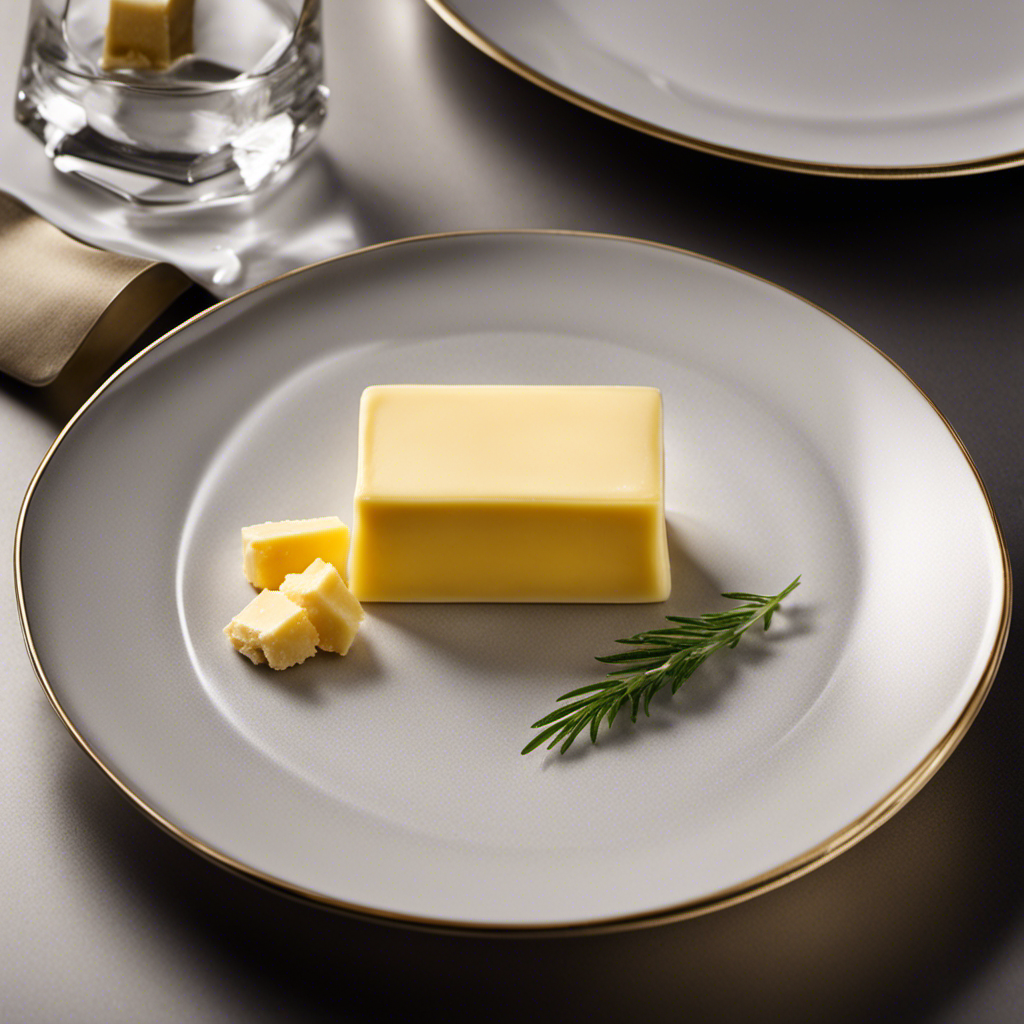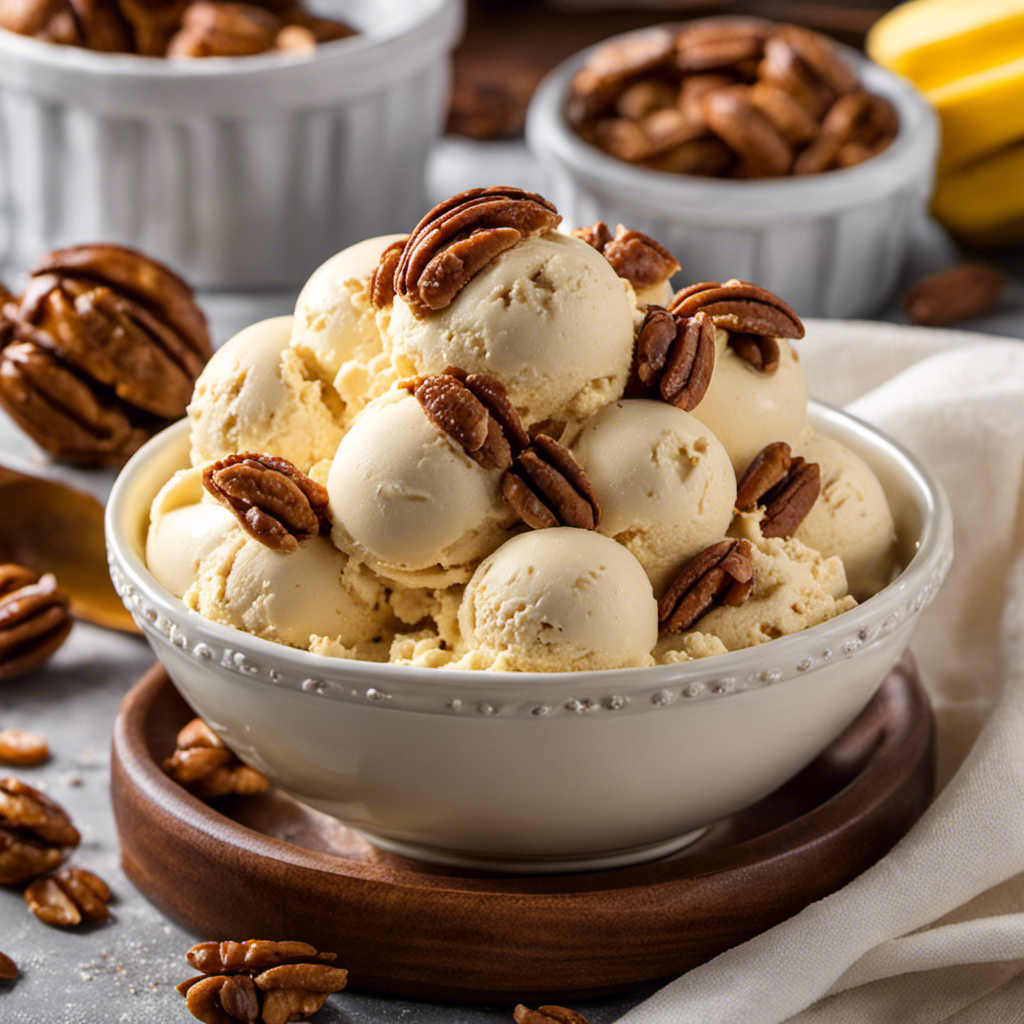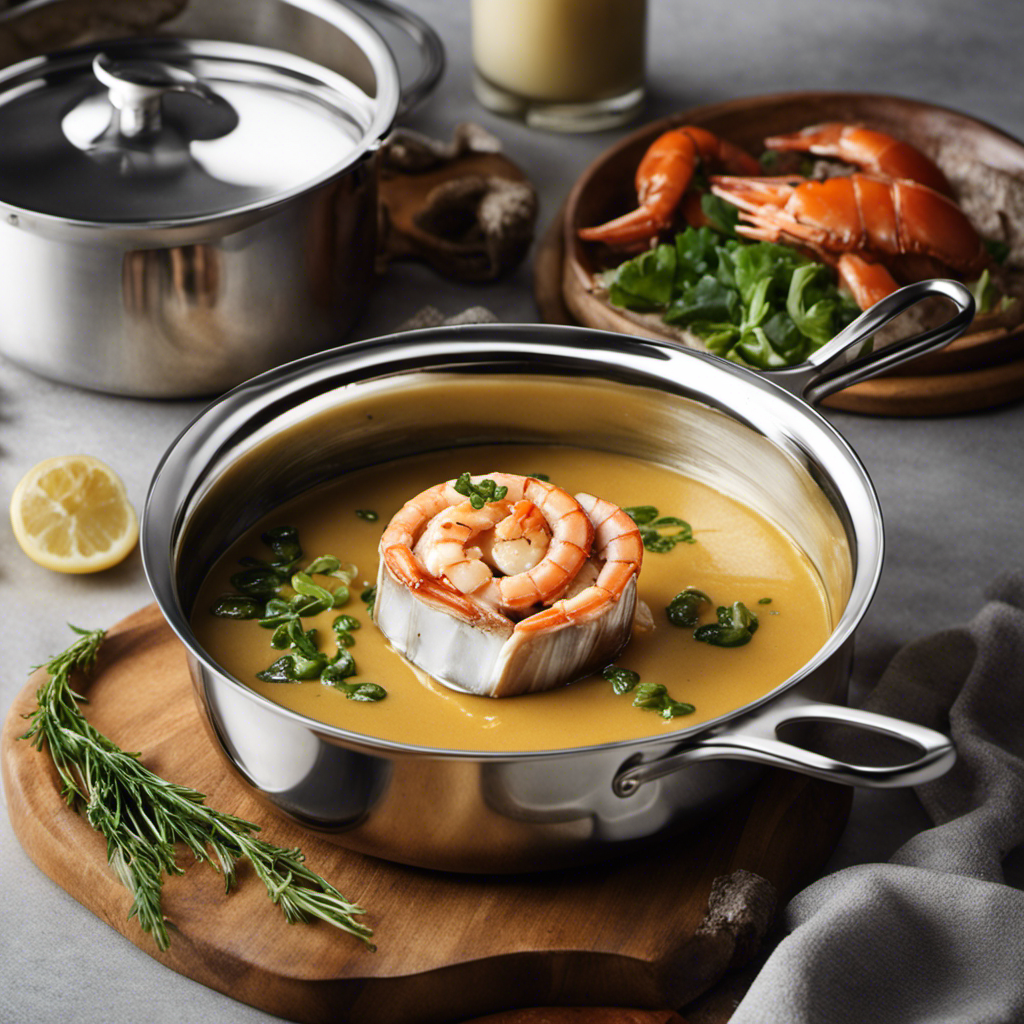I have always had a passion for seafood, and one of my top choices for a sauce to complement it is a decadent and creamy seafood butter sauce. This flavorful sauce enhances the dish, whether it be shrimp, scallops, or even lobster.
In this article, I’ll guide you through the process of creating this mouthwatering sauce, from choosing the perfect seafood to seasoning it just right. Get ready to elevate your seafood game with this irresistible seafood butter sauce recipe.
Key Takeaways
- Choosing the right seafood is important for the sauce to ensure the best flavors.
- The sauce base should be made by melting butter, adding minced garlic, and infusing flavors with shallots or herbs.
- Seasoning the sauce can be done with classic herbs and spices, Mediterranean twist, or Asian fusion flavors to enhance the taste of seafood.
- Different cooking techniques such as searing, poaching, or grilling can be used to cook the seafood in the butter sauce, offering versatility and rich flavors.
Ingredients Needed for Seafood Butter Sauce
You’ll need butter, garlic, lemon juice, white wine, and parsley for this seafood butter sauce. When it comes to choosing the right ingredients, it’s all about quality and freshness.
For the butter, opt for unsalted butter as it allows you to control the saltiness of the sauce. Fresh garlic is essential for its aromatic flavor, so make sure to mince it finely. The lemon juice adds a tangy brightness to the sauce, while the white wine imparts a subtle depth of flavor. Lastly, fresh parsley brings a touch of freshness and color to the sauce.
There are also variations of seafood butter sauce that you can explore. For instance, you can add a touch of cream to create a creamy seafood butter sauce. Alternatively, you can experiment with different herbs like dill or tarragon to give the sauce a unique twist. Don’t be afraid to get creative and adjust the ingredients to suit your taste preferences.
Choosing the Right Seafood for Your Sauce
When choosing the right seafood for your sauce, it’s important to consider the freshness and flavor profiles of different options. The best cooking techniques for seafood butter sauce include searing, poaching, or sautéing. These methods help to preserve the delicate flavors and textures of the seafood while infusing them with the rich and creamy sauce.
Depending on your preference, you can experiment with different flavor variations by using a variety of seafood such as shrimp, scallops, or crab. Each seafood option brings its unique taste and texture to the sauce, adding depth and complexity. For a lighter and sweeter flavor, shrimp works well, while scallops offer a slightly richer and buttery taste. Crab, on the other hand, gives a sweet and briny flavor to the sauce.
The key is to choose seafood that complements the buttery sauce and enhances its overall taste.
Preparing the Seafood for the Sauce
When it comes to preparing seafood for a sauce, there are a few key points to keep in mind.
First and foremost, choosing the right seafood is crucial for a successful dish. Not only should you consider the flavor and texture, but also the freshness and sustainability of the seafood you select.
Additionally, when it comes to cleaning and deveining shrimp, it is important to take the time to properly remove the shell and vein to ensure a clean and delicious final product.
Choosing the Right Seafood
To ensure the best flavor, it’s important to choose the freshest seafood for your butter sauce. When it comes to cooking techniques, selecting the right seafood is crucial. Opt for shellfish like shrimp, scallops, or crab for a rich and savory flavor profile. These seafood options work well with the creamy texture of the butter sauce.
Not only do they add a delightful taste, but they also provide several nutritional benefits. Seafood is a great source of lean protein, omega-3 fatty acids, and vitamins and minerals like iodine and selenium. Incorporating seafood into your diet can promote heart health, improve brain function, and support overall well-being.
Cleaning and Deveining Shrimp
You’ll want to start by rinsing the shrimp under cold water to remove any dirt or debris. Cleaning shrimp is an important step in preparing them for cooking.
Not only does it ensure that the shrimp are free from any unwanted particles, but it also helps to enhance their flavor. To clean shrimp, you can use a small knife or a shrimp deveiner tool. Gently cut along the back of the shrimp and remove the dark vein, also known as the digestive tract.
This process is called deveining and it is beneficial for both aesthetic and taste reasons. Removing the vein can improve the texture and appearance of the shrimp, making them more visually appealing. Additionally, deveining can eliminate any potential bitterness that the vein may bring to the dish.
Making the Base of the Butter Sauce
Making the base of the butter sauce is as simple as melting butter and adding minced garlic. This forms the foundation for a rich and flavorful sauce that complements a variety of seafood dishes.
Here are some tips for making a flavorful base:
-
Choosing the right seafood: The type of seafood you use will greatly impact the taste of your butter sauce. Opt for fresh and high-quality seafood, such as shrimp, scallops, or lobster, to ensure a delicious result.
-
Infusing flavors: Besides garlic, you can add other ingredients like shallots, herbs, or even a splash of white wine to enhance the flavor of your butter sauce. Experiment with different combinations to find your favorite.
-
Balancing acidity: To balance the richness of the butter, consider adding a squeeze of lemon juice or a dash of vinegar. This will brighten the flavors and add a tangy kick to your sauce.
Adding the Seafood to the Sauce
Now that the base is ready, it’s time to incorporate the delicious seafood into the sauce. To create a flavorful seafood butter sauce, it’s important to use the right cooking techniques and explore different flavor variations.
One popular technique is sautéing the seafood in butter before adding it to the sauce. This helps to enhance the natural flavors of the seafood and infuse it with the richness of the butter. You can also experiment with different types of seafood such as shrimp, scallops, or even lobster to create a unique and tasty sauce.
Additionally, you can add herbs like parsley or dill to bring freshness and depth to the sauce. By incorporating seafood into the butter sauce, you’ll elevate the flavors and create a delectable and versatile accompaniment to your dishes.
Seasoning the Seafood Butter Sauce
To enhance the flavors of the seafood butter sauce, it’s important to season it with a variety of herbs and spices. Seasoning techniques play a crucial role in elevating the taste and aroma of any dish, and the seafood butter sauce is no exception. Here are some flavor variations and seasoning techniques to consider:
-
Classic Herbs and Spices:
-
Freshly ground black pepper
-
Sea salt
-
Garlic powder
-
Mediterranean Twist:
-
Dried oregano
-
Lemon zest
-
Red pepper flakes
-
Asian Fusion:
-
Ginger powder
-
Soy sauce
-
Sesame oil
By incorporating these herbs and spices, you can create a seafood butter sauce that is bursting with flavors and complements the natural taste of the seafood.
Now that we’ve seasoned the sauce, let’s move on to the exciting part – cooking the seafood in the butter sauce.
Cooking the Seafood in the Butter Sauce
Once the sauce is seasoned, it’s time to cook the seafood in it. Cooking seafood in butter sauce requires careful attention to cooking techniques to ensure that the flavors are perfectly infused. There are various methods you can use to cook the seafood in the butter sauce, each offering its own unique flavor variations.
One popular cooking technique for seafood in butter sauce is pan-searing. This involves heating a skillet over medium-high heat and adding the seafood, allowing it to cook for a few minutes on each side until it is cooked through and has a golden brown crust. This method gives the seafood a slightly crispy texture while allowing it to absorb the rich flavors of the butter sauce.
Another technique is poaching, which involves gently simmering the seafood in the butter sauce until it is tender and cooked to perfection. This method is ideal for delicate seafood such as shrimp or scallops, as it ensures that they remain juicy and succulent.
For a more intense flavor, you can also grill the seafood in the butter sauce. This imparts a smoky charred flavor that adds depth to the dish. Simply brush the seafood with the butter sauce and grill it over medium-high heat until it is cooked through, making sure to baste it with more sauce throughout the cooking process.
When it comes to flavor variations, you can experiment by adding different herbs and spices to the butter sauce. For a Mediterranean twist, you can add chopped fresh basil, garlic, and lemon zest. If you prefer a spicy kick, try adding chili flakes or cayenne pepper. The possibilities are endless, so don’t be afraid to get creative and tailor the flavor to your liking.
Cooking seafood in butter sauce is a versatile and delicious way to enjoy your favorite seafood. By using different cooking techniques and incorporating flavor variations, you can create a dish that is bursting with rich and savory flavors. So go ahead, grab that skillet or fire up the grill, and let the seafood shine in the delectable butter sauce.
Serving Suggestions for Seafood Butter Sauce
When it comes to serving seafood butter sauce, there are endless pairing options to choose from. From succulent lobster tails to delicate shrimp, this versatile sauce complements a variety of seafood dishes.
In this discussion, we will explore the best seafood combinations that beautifully enhance the flavors of the butter sauce, providing a truly delectable dining experience.
Pairing Options for Sauce
You can pair the seafood butter sauce with grilled shrimp or steamed lobster for a delicious meal. Here are some pairing options to enhance your dining experience:
-
Best Wine: A crisp and refreshing white wine, such as a Sauvignon Blanc or Chardonnay, complements the richness of the seafood butter sauce. The acidity in the wine cuts through the buttery flavors, balancing the dish perfectly.
-
Alternative Sauces: While seafood butter sauce is a classic choice, there are other sauces you can try for a different twist. Consider a tangy lemon butter sauce for a zesty kick or a creamy garlic butter sauce for a more indulgent flavor.
-
Creative Pairings: Don’t limit yourself to just shrimp or lobster! Seafood butter sauce can also be drizzled over grilled fish fillets, seared scallops, or even roasted vegetables for a vegetarian option. The versatility of this sauce allows you to experiment and create unique combinations.
Best Seafood Combinations
For a delectable meal, try pairing the seafood butter sauce with grilled shrimp or steamed lobster. These are the best seafood pairings that perfectly complement the rich and creamy flavors of the sauce.
The succulent grilled shrimp brings a delightful smoky flavor that pairs wonderfully with the buttery goodness of the sauce. If you prefer a more delicate seafood option, steamed lobster is a fantastic choice. The tender, sweet meat of the lobster absorbs the flavors of the sauce, creating a heavenly combination.
While the seafood butter sauce is a classic choice, there are also alternative sauces for seafood that you can experiment with to find your perfect pairings.
Now, let’s dive into some tips and tricks for perfecting seafood butter sauce.
Tips and Tricks for Perfecting Seafood Butter Sauce
To perfect your seafood butter sauce, make sure to use fresh ingredients and keep the heat at a low simmer. This will ensure that the flavors meld together beautifully and that the sauce doesn’t break or become watery.
Here are some tips and tricks to help you create the perfect seafood butter sauce:
- Seafood sauce variations:
- Experiment with different types of seafood, such as shrimp, scallops, or lobster, to create unique flavor combinations.
- Add a splash of white wine or lemon juice to give the sauce a tangy twist.
- Incorporate herbs like parsley, dill, or tarragon for added freshness and complexity.
Troubleshooting common sauce problems:
- If the sauce separates or becomes greasy, try incorporating a small amount of cold butter to emulsify it.
- If the sauce is too thick, add a little bit of warm water or seafood stock to thin it out.
- If the sauce lacks flavor, try adding a pinch of salt or a squeeze of lemon juice to enhance the taste.
Frequently Asked Questions
Can I Use Frozen Seafood for This Recipe?
Yes, you can use frozen seafood for this recipe. However, fresh seafood will have a better flavor and texture. Canned seafood can also be used as an alternative to frozen seafood, but it may affect the overall taste of the sauce.
How Long Can I Store the Seafood Butter Sauce in the Refrigerator?
The shelf life of seafood butter sauce depends on proper storage techniques. It can be stored in the refrigerator for up to five days. Remember, "waste not, want not" – use it before it goes bad!
Can I Substitute Regular Butter With Margarine for This Sauce?
Yes, you can substitute regular butter with margarine in seafood butter sauce. However, keep in mind that the flavor and texture may be slightly different. When using margarine in seafood recipes, opt for one with a high fat content for better results.
Can I Use Any Type of Seafood for This Sauce, or Are Certain Types Better?
When it comes to seafood butter sauce, the type of seafood you use can make all the difference. Some types, like shrimp and scallops, work particularly well. Just remember to use fresh seafood for the best flavor.
Can I Make This Sauce Without Using Any Seafood?
Making a vegetarian version of seafood butter sauce is possible by using alternatives to seafood. There are various options such as using mushrooms, tofu, or even vegetables as substitutes to create a flavorful and delicious sauce.
Conclusion
In conclusion, making seafood butter sauce is a delightful culinary adventure that will transport your taste buds to a seaside paradise.
Just like a gentle ocean breeze, this sauce adds a touch of richness and elegance to any seafood dish.
By following the steps outlined in this article, you can confidently create a velvety smooth sauce that perfectly complements your favorite seafood.
So go ahead and dive into the world of seafood butter sauce, and let your culinary skills shine like a pearl in the sea.










